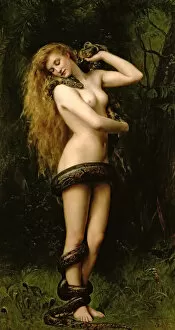Lilith Collection
"Lilith: Unveiling the Enigmatic Figure of Classical Myth and Magic" In the realm of classical mythology, Lilith emerges as a captivating and mysterious character
All Professionally Made to Order for Quick Shipping
"Lilith: Unveiling the Enigmatic Figure of Classical Myth and Magic" In the realm of classical mythology, Lilith emerges as a captivating and mysterious character. From ancient incantations inscribed on magic bowls to mesmerizing artistic depictions spanning centuries, her presence has left an indelible mark on various cultures. Dating back to the 5th-6th century, a remarkable artifact reveals a Judeo-Aramaic text accompanied by an image herself. This magical bowl offers glimpses into the beliefs surrounding this enigmatic demoness. Fast forward to 1887 when Lilith takes center stage in art with Dante Gabriel Rossetti's masterpiece aptly titled "Lilith. " The painting captures her ethereal beauty and alluring aura, leaving viewers spellbound by her enchanting gaze. The story of Adam and Eve finds new depth in Barbera del Valles' fresco from Catalonia, Spain. Here, we witness Lilith's absence as she is replaced by Eve—a subtle nod to the complex relationship between these two mythical figures. John Milton's renowned epic poem "Paradise Lost" further immortalizes Lilith through his vivid descriptions. His words transport readers into realms where temptation reigns supreme, showcasing Lilith's seductive prowess amidst chaos and rebellion. Artists throughout history have been captivated by this beguiling figure. A study for "Lilith" created around 1900 showcases intricate chalk sketches that delve into the essence of her allure—an exploration that continues to fascinate even today. Dante Gabriel Rossetti returns alongside Henry Treffry Dunn in their collaborative work titled "Lady Lilith. " This haunting portrayal intertwines sensuality with danger as they depict her as both beautiful muse and dangerous temptress—a duality that defines her character. Beyond mythology and artistry lies another facet—vampires. Legends intertwine with folklore as vampires are often associated with Lilith, the progenitor of these nocturnal creatures.


















